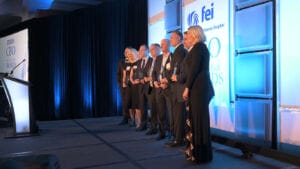Businesses are currently facing one of the most severe employee engagement crises in history. Burnout, dissatisfaction, transactional mindsets, and a global political climate that leaves people either raging with anger or paralyzed by fear are colliding with a “doom scroll” culture fueled by social media. Add in the lingering effects of Long COVID, a complex generational baton pass and shifting workforce expectations, and the challenge for leaders is clear: business-as-usual thinking no longer works. Making a bad hire just compounds the challenges.
Now more than ever, you have to make sure you’re hiring the right people, for the right reasons, for the right role, because opting out of the job and continuing to get paid for that job is easier than ever in remote and hybrid environments.
Most CEOs and managers understand the financial cost of a bad hire. However, the deeper, systemic damage often goes unnoticed until it’s too late. Outdated hiring practices can lead to four costly consequences.
LOCAL NEWS: 100 best places to work and live in Arizona for 2025
INDUSTRY INSIGHTS: Want more news like this? Get our free newsletter here
1. Fragmented Customer Service
Great service begins with understanding your product or service and why customers use it. Skills and knowledge can be taught. Caring cannot.
Behavioral and performance research shows that excellent service flows from a set of values, attitudes, and beliefs aligned with your service philosophy. When someone takes a customer service role for the wrong reasons, no training will overcome their lack of connection to the work. Customers feel it in the form of apathy, indifference, and mechanical responses.
In today’s market, expectations are higher than ever, and a single bad interaction can be broadcast instantly across social channels. When a mis-hire ends up in customer service, your brand reputation, retention, and revenue all take a hit.
Hire for the “Service Centralizer” trait—people who genuinely value connection, measure success by the customer’s experience, and recognize that products and services matter only because of the benefits they create. These individuals are loyal, mission-driven, and committed to serving both customers and community.
Interview tip: Early in the process, ask candidates how they measure success, how they know customers are satisfied, and how they handle challenges. Look for solution-oriented, empathetic responses that reflect a service-oriented mindset.

2. Depleted Problem Solving
When you hire purely on resume keywords without screening for values, conceptual thinking, and adaptive problem solving, you risk bringing in someone who doesn’t want or know how to solve problems.
Instead of initiative, you get excuses. Instead of collaboration, you get finger pointing. These are the people who see obstacles rather than opportunities, resist change, and let deadlines slip because “the system” is at fault.
The truth is, problem-solving competencies are difficult to teach. That’s why you must assess them before hiring. The best problem solvers are proactive rather than reactive. They focus on what they can control, refuse to waste time blaming, and look for ways to influence outcomes.
Key competencies to hire for: initiative, self-confidence, and practical thinking.
Interview tip: Ask candidates to share a situation where they encountered a major obstacle. Listen for how they took ownership, generated options, and followed through, not just what the result was.
3. Eroding Workforce Productivity
Rushed hiring decisions almost always lead to turnover. The wrong fit may take months to reveal itself, but by then the damage is done.
Gallup reports that only 31% of U.S. employees are actively engaged, while 17% are actively disengaged. Hybrid work, shifting generational expectations, and the lasting effects of Long COVID are reshaping productivity norms. Some employees are managing chronic health conditions, energy fluctuations, and cognitive fatigue, all of which affect output and morale.
Generational differences further complicate the picture. What motivated Boomers may not resonate with Gen Z. Leaders now must navigate a workplace that requires adaptability, empathy, and clarity about performance expectations.
Leaders themselves are also under pressure. This year, has seen a spike in C-suite terminations, hostile work environment claims, and executive-level turnover. Many leadership missteps aren’t new. They’re simply less tolerated in today’s environment.
In a world full of distractions, leaders need the behaviors that inspire others to engage fully in their roles, and, for non-managers, the skills to direct their own work, avoid distractions, and deliver results.
Hire for resilience, initiative, and self-direction. Look for candidates who can recover from stress, adapt to shifting demands, and stay on track without constant oversight.
Interview tip: Use open-ended questions like, “How much direction do you need to get started?” or “If circumstances changed at the last minute and you needed to work outside normal hours, how would you handle it?”
4. Time and Energy Losses for the Team and Leadership
You’ve heard the saying: 80% of a manager’s time is spent with the bottom 20% of performers. The competition for talent can tempt you to hire the first decent resume that comes across your desk. However, filling a seat quickly can result in empty seats later, or worse: full seats with no payoff.
This is also creating exhaustion for managers. In a survey done at the end of 2024, 53% of managers reported feeling burned out. Many are stuck in roles of correction, babysitting, and micromanagement, which stifles creativity, erodes culture, and turns leadership into damage control.
This exhaustion often stems from repeated mis-hires, a lack of coherent hiring strategy, and a broken feedback loop. Too many leaders delegate “fixing people” to HR or wait too long to address performance issues, allowing disengagement to spread.
Leaders need to act as coaches, not commanders, and organizations that are responsive, not reactive. That requires hiring systems rooted in clarity, cultural alignment, and conscious decision-making.
Conscious Hiring in a Distracted, Fast-Moving World
Distractions and disruptions aren’t going away. We’ll be navigating generational transitions for at least the next 5–6 years, and AI and technological advancements will only accelerate the pace of change.
This makes clarity in hiring more critical than ever. You must know exactly who you are hiring, why you are hiring them, and what you need from them. That begins with starting with the end in mind.
Ask yourself:
- If the company could talk, what would it say is the purpose of this role?
- What return on investment should this role produce?
- If the role could speak, what competencies, attitudes, beliefs, and experiences would it ask for?
The first step in Conscious Hiring is role analysis. From there, design interview questions that reveal how a candidate thinks, acts under pressure, and aligns with your mission and values.
If hiring the right people for the right role matters to you (and it should), then you need to hire slowly, hire mindfully and hire with the end in mind.
Author: Margaret Graziano, known as the Evolutionist, is the founder and CEO of KeenAlignment, as well as a Wall Street Journal Best-Selling Author for her book “Ignite Culture.” She has been recognized as one of Silicon Valley’s Top 100 Women Leaders. Magi’s groundbreaking work is driven by her power to uncover and catalyze human potential. Go to https://www.keenalignment.com/ for more information.




